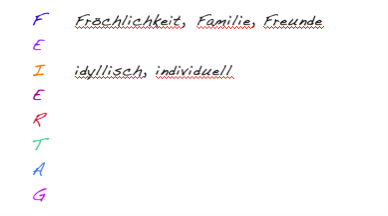Poetry
Acrostic poetry
In an acrostic poem, the first letter of each word together spell out a word or phrase. To begin, students or instructors select a key term and use its letters to find words related to that term. The example below, from a first-year German online language program called Deutsch im Blick, is about holidays (der Feiertag). This type of poetry can be used effectively at all levels of instruction to explore topics, or cultural, literary, and media concepts (e.g., "Film Noir").

Name poem
For a fun variant of an acrostic poem, ask students to write their name vertically on a sheet of paper and write adjectives, nouns, verbs, or entire phrases next to each letter that describes them. Here, you can see a video of an example where two graduate students tried out the activity.
Writing name poems and a discussion about the form.
Duration: 02:38
Cinquain poetry
This poem consists of five lines (hence the name "cinquain") that explore learners' notions of a concept (person, event, genre). It can be used at any language level and in any course. For example, in a Spanish literature class, have students interpret Don Quixote and how they view the main character or his struggles.
| Line 1: | State a subject in one word (noun) |
|---|---|
| Line 1: | Describe subject in two words (adjectives) |
| Line 1: | Describe action about the subject in three words (infinitives/a phrase) |
| Line 1: | Express an emotion about the subject in four words |
| Line 1: | Restate subject in a single word |
| Cinquain poem about the "Night" by a first year German student | |
|---|---|
Nachtzeit dunkel, umheimlich kann fetzig bekommen ich liebe es durchaus Nachtzeit |
Night time dark, eerie can be cool (here: fun, exciting) I love it thoroughly Night time |